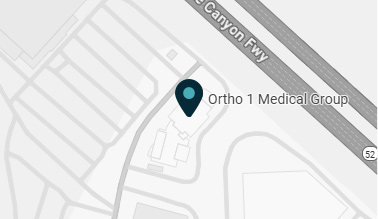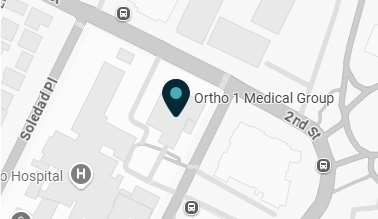Anatomy of the Cubital Tunnel
The ulnar nerve travels down the back of the elbow behind a bony bump called the medial epicondyle, and through a passageway called the cubital tunnel. The cubital tunnel is a narrow passageway on the inside of the elbow formed by bone, muscle, and ligaments. The roof of the cubital tunnel is covered with a soft tissue called fascia.
What is Cubital Tunnel Syndrome?
When the elbow is bent, the ulnar nerve can stretch and catch on the bony bump. When the ulnar nerve is compressed or entrapped, the nerve can tear and become inflamed, leading to cubital tunnel syndrome.
What are the Signs and Symptoms of Cubital Tunnel Syndrome?
In general, the signs and symptoms of cubital tunnel syndrome arise gradually, progressing to the point where you have to seek medical attention. Left untreated, cubital tunnel syndrome can lead to permanent nerve damage in the hand. The commonly reported symptoms associated with cubital tunnel syndrome include:
- Intermittent numbness, tingling, and pain to the little finger, ring finger and inside of the hand. These symptoms occur more frequently at night, and with elbow bending or prolonged resting on the elbow.
- Aching pain to the inside of the elbow
- Weakness in hand with diminished grip strength
- Diminished sensation and fine motor control in the hand, causing you to drop objects or have difficulty in handling small objects
- Muscle wasting in the hand and permanent nerve damage, if left untreated
What are the Causes of Cubital Tunnel Syndrome?
The common causes responsible for cubital tunnel syndrome include:
- Trauma
- Repetitive motion
- Frequent pressure on the elbow for extended periods due to sitting posture
- Medical conditions such as bone spurs, ganglion cysts or tumors in the cubital tunnel, leading to pressure and irritation of the ulnar nerve
Diagnosis of Cubital Tunnel Syndrome
Your physician will review your medical history and perform a thorough physical examination of your elbow.
Your physician may order X-ray and electrodiagnostic tests such as electromyography and nerve conduction studies. These tests can assist your doctor in determining how well the nerve is functioning and locate areas of muscle wasting and nerve compression.
Treatment Options for Cubital Tunnel Syndrome
Your physician will initially recommend conservative treatment options to treat the symptoms unless muscle wasting or nerve damage is present.
Conservative Treatment Options for Cubital Tunnel Syndrome
Conservative treatment options may include:
- Avoid frequent bending of the elbow.
- Avoid pressure to the elbow by not leaning on it. Elbow pads may be worn to decrease pressure when working at a desk.
- Wear a brace or splint at night while sleeping to keep the elbow in a straight position. You can also wrap the arm loosely with a towel and apply tape to hold it in place.
- Avoid activities that tend to bring on the symptoms.
- Non-steroidal anti-inflammatory drugs (NSAIDs) may be ordered to reduce swelling.
- Referral to occupational therapy for strengthening and stretching exercises may be recommended.
Surgery for Cubital Tunnel Syndrome
If conservative treatment options fail to resolve the condition or if muscle wasting or severe nerve compression is present, your surgeon may recommend a surgical procedure to treat your condition.
The goal of cubital tunnel surgery is to reduce the pressure on the ulnar nerve by providing more space for the nerve to move freely and to increase blood flow for the ulnar nerve to heal. There are different surgeries that can be performed to treat your condition, such as:
- Medial epicondylectomy: Involves removing the medial epicondyle, the bony bump on the inside of the elbow, enabling the ulnar nerve to glide smoothly when the elbow is flexed and straightened
- Ulnar nerve transposition: Involves creating a new tunnel in front of the medial epicondyle and transposing (moving) the ulnar nerve to the new tunnel
Your surgeon will decide which option is best for you depending on your specific circumstances.
Postoperative Care for Cubital Tunnel Surgery
After surgery, your surgeon will give you guidelines to follow depending on the type of repair performed. Common postoperative procedures include:
- A bulky dressing with a plaster splint is usually applied following surgery for 10-14 days.
- Elevating the arm above heart level and moving the fingers are important to prevent swelling.
- The arm dressing is removed after 10-14 days for the removal of sutures.
- Elbow immobilization for 3 weeks after surgery or longer is usually indicated, depending on the repair performed.
- Ice packs are applied to the surgical area to reduce swelling. Ice should be applied over a towel on the affected area for 20 minutes every hour. The surgical incision should be kept clean and dry. Cover the area with plastic wrap when bathing or showering.
- Occupational therapy will be ordered a few weeks after surgery for strengthening and stretching exercises to maximize the use of the hand and forearm.
Risks and Complications of Cubital Tunnel Surgery
There are mostly no complications following cubital tunnel surgery; however, complications can occur following elbow surgery and may include:
- Infection
- Nerve damage causing permanent numbness around the elbow or forearm
- Elbow instability
- Elbow flexion contracture
- Pain at the site of the scar
- Symptoms unresolved even after the surgery




















